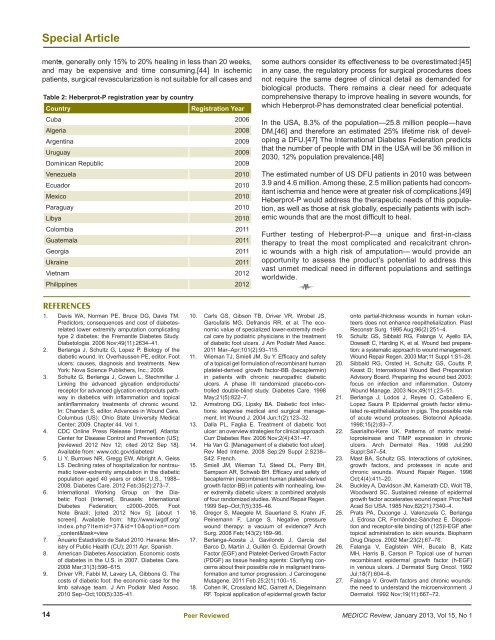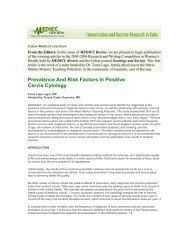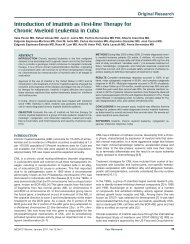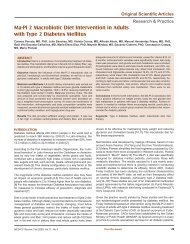Heberprot-P: A Novel Product for Treating Advanced Diabetic Foot ...
Heberprot-P: A Novel Product for Treating Advanced Diabetic Foot ...
Heberprot-P: A Novel Product for Treating Advanced Diabetic Foot ...
Create successful ePaper yourself
Turn your PDF publications into a flip-book with our unique Google optimized e-Paper software.
Special Article<br />
ments, generally only 15% to 20% healing in less than 20 weeks,<br />
and may be expensive and time consuming.[44] In ischemic<br />
patients, surgical revascularization is not suitable <strong>for</strong> all cases and<br />
Table 2: <strong>Heberprot</strong>-P registration year by country<br />
Country Registration Year<br />
Cuba 2006<br />
Algeria 2008<br />
Argentina 2009<br />
Uruguay 2009<br />
Dominican Republic 2009<br />
Venezuela 2010<br />
Ecuador 2010<br />
Mexico 2010<br />
Paraguay 2010<br />
Libya 2010<br />
Colombia 2011<br />
Guatemala 2011<br />
Georgia 2011<br />
Ukraine 2011<br />
Vietnam 2012<br />
Philippines 2012<br />
REFERENCES<br />
1. Davis WA, Norman PE, Bruce DG, Davis TM.<br />
Predictors, consequences and cost of diabetesrelated<br />
lower extremity amputation complicating<br />
type 2 diabetes: the Fremantle Diabetes Study.<br />
Diabetologia. 2006 Nov;49(11):2634–41.<br />
2. Berlanga J, Schultz G, Lopez P. Biology of the<br />
diabetic wound. In: Overhaussen PE, editor. <strong>Foot</strong><br />
ulcers: causes, diagnosis and treatments. New<br />
York: Nova Science Publishers, Inc.; 2009.<br />
3. Schultz G, Berlanga J, Cowan L, Stechmiller J.<br />
Linking the advanced glycation endproducts/<br />
receptor <strong>for</strong> advanced glycation endproduts pathway<br />
in diabetics with infl ammation and topical<br />
antiinfl ammatory treatments of chronic wound.<br />
In: Chandan S, editor. Advances in Wound Care.<br />
Columbus (US): Ohio State University Medical<br />
Center; 2009. Chapter 44. Vol 1.<br />
4. CDC Online Press Release [Internet]. Atlanta:<br />
Center <strong>for</strong> Disease Control and Prevention (US);<br />
[reviewed 2012 Nov 12; cited 2012 Sep 18].<br />
Available from: www.cdc.gov/diabetes/<br />
5. Li Y, Burrows NR, Gregg EW, Albright A, Geiss<br />
LS. Declining rates of hospitalization <strong>for</strong> nontraumatic<br />
lower-extremity amputation in the diabetic<br />
population aged 40 years or older: U.S., 1988–<br />
2008. Diabetes Care. 2012 Feb;35(2):273–7.<br />
6. International Working Group on the <strong>Diabetic</strong><br />
<strong>Foot</strong> [Internet]. Brussels: International<br />
Diabetes Federation; c2000–2005. <strong>Foot</strong><br />
Note Brazil; [cited 2012 Nov 5]; [about 1<br />
screen]. Available from: http://www.iwgdf.org/<br />
index.php?Itemid=37&id=10&option=com<br />
_content&task=view<br />
7. Anuario Estadístico de Salud 2010. Havana: Ministry<br />
of Public Health (CU); 2011 Apr. Spanish.<br />
8. American Diabetes Association. Economic costs<br />
of diabetes in the U.S. in 2007. Diabetes Care.<br />
2008 Mar;31(3):596–615.<br />
9. Driver VR, Fabbi M, Lavery LA, Gibbons G. The<br />
costs of diabetic foot: the economic case <strong>for</strong> the<br />
limb salvage team. J Am Podiatr Med Assoc.<br />
2010 Sep–Oct;100(5):335–41.<br />
14<br />
10. Carls GS, Gibson TB, Driver VR, Wrobel JS,<br />
Garoufalis MG, Defrancis RR, et al. The economic<br />
value of specialized lower-extremity medical<br />
care by podiatric physicians in the treatment<br />
of diabetic foot ulcers. J Am Podiatr Med Assoc.<br />
2011 Mar–Apr;101(2):93–115.<br />
11. Wieman TJ, Smiell JM, Su Y. Effi cacy and safety<br />
of a topical gel <strong>for</strong>mulation of recombinant human<br />
platelet-derived growth factor-BB (becaplermin)<br />
in patients with chronic neuropathic diabetic<br />
ulcers. A phase III randomized placebo-controlled<br />
double-blind study. Diabetes Care. 1998<br />
May;21(5):822–7.<br />
12. Armstrong DG, Lipsky BA. <strong>Diabetic</strong> foot infections:<br />
stepwise medical and surgical management.<br />
Int Wound J. 2004 Jun;1(2):123–32.<br />
13. Dalla PL, Faglia E. Treatment of diabetic foot<br />
ulcer: an overview strategies <strong>for</strong> clinical approach.<br />
Curr Diabetes Rev. 2006 Nov;2(4):431–47.<br />
14. Ha Van G. [Management of a diabetic foot ulcer].<br />
Rev Med Interne. 2008 Sep;29 Suppl 2:S238–<br />
S42. French.<br />
15. Smiell JM, Wieman TJ, Steed DL, Perry BH,<br />
Sampson AR, Schwab BH. Effi cacy and safety of<br />
becaplermin (recombinant human platelet-derived<br />
growth factor-BB) in patients with nonhealing, lower<br />
extremity diabetic ulcers: a combined analysis<br />
of four randomized studies. Wound Repair Regen.<br />
1999 Sep–Oct;7(5):335–46.<br />
16. Gregor S, Maegele M, Sauerland S, Krahn JF,<br />
Peinemann F, Lange S. Negative pressure<br />
wound therapy: a vacuum of evidence? Arch<br />
Surg. 2008 Feb;143(2):189–96.<br />
17. Berlanga-Acosta J, Gavilondo J, García del<br />
Barco D, Martín J, Guillén G. Epidermal Growth<br />
Factor (EGF) and Platelet-Derived Growth Factor<br />
(PDGF) as tissue healing agents: Clarifying concerns<br />
about their possible role in malignant trans<strong>for</strong>mation<br />
and tumor progression. J Carcinogene<br />
Mutagene. 2011 Feb 25;2(1):100–15.<br />
18. Cohen IK, Crossland MC, Garrett A, Diegelmann<br />
RF. Topical application of epidermal growth factor<br />
Peer Reviewed<br />
some authors consider its effectiveness to be overestimated:[45]<br />
in any case, the regulatory process <strong>for</strong> surgical procedures does<br />
not require the same degree of clinical detail as demanded <strong>for</strong><br />
biological products. There remains a clear need <strong>for</strong> adequate<br />
comprehensive therapy to improve healing in severe wounds, <strong>for</strong><br />
which <strong>Heberprot</strong>-P has demonstrated clear benefi cial potential.<br />
In the USA, 8.3% of the population—25.8 million people—have<br />
DM,[46] and there<strong>for</strong>e an estimated 25% lifetime risk of developing<br />
a DFU.[47] The International Diabetes Federation predicts<br />
that the number of people with DM in the USA will be 36 million in<br />
2030, 12% population prevalence.[48]<br />
The estimated number of US DFU patients in 2010 was between<br />
3.9 and 4.6 million. Among these, 2.5 million patients had concomitant<br />
ischemia and hence were at greater risk of complications.[49]<br />
<strong>Heberprot</strong>-P would address the therapeutic needs of this population,<br />
as well as those at risk globally, especially patients with ischemic<br />
wounds that are the most diffi cult to heal.<br />
Further testing of <strong>Heberprot</strong>-P—a unique and fi rst-in-class<br />
therapy to treat the most complicated and recalcitrant chronic<br />
wounds with a high risk of amputation— would provide an<br />
opportunity to assess the product’s potential to address this<br />
vast unmet medical need in different populations and settings<br />
worldwide.<br />
onto partial-thickness wounds in human volunteers<br />
does not enhance reepithelialization. Plast<br />
Reconstr Surg. 1995 Aug;96(2):251–4.<br />
19. Schultz GS, Sibbald RG, Falanga V, Ayello EA,<br />
Dowsett C, Harding K, et al. Wound bed preparation:<br />
a systematic approach to wound management.<br />
Wound Repair Regen. 2003 Mar;11 Suppl 1:S1–28.<br />
20. Sibbald RG, Orsted H, Schultz GS, Coutts P,<br />
Keast D; International Wound Bed Preparation<br />
Advisory Board. Preparing the wound bed 2003:<br />
focus on infection and infl ammation. Ostomy<br />
Wound Manage. 2003 Nov;49(11):23–51.<br />
21. Berlanga J, Lodos J, Reyes O, Caballero E,<br />
Lopez Saura P. Epidermal growth factor stimulated<br />
re-epithelialization in pigs. The possible role<br />
of acute wound proteases. Biotecnol Aplicada.<br />
1998;15(2):83–7.<br />
22. Saarialho-Kere UK. Patterns of matrix metalloproteinase<br />
and TIMP expression in chronic<br />
ulcers. Arch Dermatol Res. 1998 Jul;290<br />
Suppl:S47–54.<br />
23. Mast BA, Schultz GS. Interactions of cytokines,<br />
growth factors, and proteases in acute and<br />
chronic wounds. Wound Repair Regen. 1996<br />
Oct;4(4):411–20.<br />
24. Buckley A, Davidson JM, Kamerath CD, Wolt TB,<br />
Woodward SC. Sustained release of epidermal<br />
growth factor accelerates wound repair. Proc Natl<br />
Acad Sci USA. 1985 Nov;82(21):7340–4.<br />
25. Prats PA, Duconge J, Valenzuela C, Berlanga<br />
J, Edrosa CR, Fernández-Sánchez E. Disposition<br />
and receptor-site binding of (125)I-EGF after<br />
topical administration to skin wounds. Biopharm<br />
Drug Dispos. 2002 Mar;23(2):67–76.<br />
26. Falanga V, Eaglstein WH, Bucalo B, Katz<br />
MH, Harris B, Carson P. Topical use of human<br />
recombinant epidermal growth factor (h-EGF)<br />
in venous ulcers. J Dermatol Surg Oncol. 1992<br />
Jul;18(7):604–6.<br />
27. Falanga V. Growth factors and chronic wounds:<br />
the need to understand the microenvironment. J<br />
Dermatol. 1992 Nov;19(11):667–72.<br />
MEDICC Review, January 2013, Vol 15, No 1






